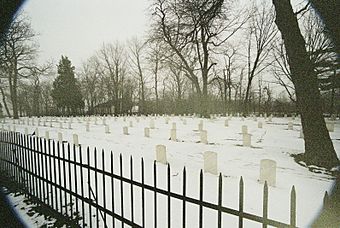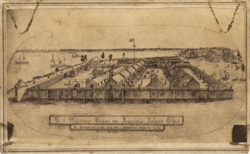Johnson's Island facts for kids
|
Johnson Island Civil War Prison and Fort Site
|
|

The cemetery at Johnson's Island
|
|
| Location | Johnson's Island, Marblehead, Ottawa County, Ohio, United States |
|---|---|
| Built | 1862 |
| Architect | Hoffman, Col. William H.; Et al. |
| NRHP reference No. | 75001514 |
Quick facts for kids Significant dates |
|
| Added to NRHP | March 27, 1975 |
| Designated NHL | June 21, 1990 |
| Johnson's Island Prison | |
|---|---|
| Part of American Civil War prison camps | |
| Johnson's Island, Marblehead, Ottawa County, Ohio, United States | |

Johnson's Island Prison barracks enclosed by a stockade in 1865
|
|
| Type | Union Prison Camp |
| Site information | |
| Owner | L. B. Johnson, U.S. Government |
| Controlled by | Union Army |
| Site history | |
| In use | 1862–1865 |
| Demolished | 1865 |
| Battles/wars | American Civil War |
| Garrison information | |
| Occupants | Union soldiers, Confederate officer prisoners of war |
Johnson's Island is a beautiful island about 300 acres big, located in Sandusky Bay on the coast of Lake Erie. It's about 3 miles from the city of Sandusky, Ohio. During the American Civil War, this island became a special place: it was a prison camp for Confederate officers who were captured.
At first, Johnson's Island was the only Union prison just for Confederate officers. But over time, it also held other captured soldiers, people involved in secret activities, and even civilians who were fighting outside the main armies. More than 15,000 men were held here during the three years it was open.
The island got its name from L. B. Johnson, who owned it around 1852. Before that, it was called 'Bull's Island' by its first owner, Epaphras W. Bull, back in 1809.
Contents
Johnson's Island During the Civil War
In late 1861, leaders in the U.S. decided Johnson's Island was a good spot for a prison camp. It could hold up to 2,500 captured Confederate officers. The island was easy to reach by ship, which was great for bringing in building materials and supplies. Sandusky Bay also offered better protection from bad weather compared to other islands. Plus, there were plenty of hickory and oak trees for wood and fuel. The U.S. government rented half the island from its owner, Leonard B. Johnson, for $500 a year. They kept a close watch on who came and went during the war.
Building the Prison Camp
The prison, covering about 16.5 acres, opened in April 1862. A tall wooden fence, about 15 feet high, surrounded the main area. Inside, there were 12 two-story buildings for prisoners, a hospital, restrooms, a store, three wells, and two large dining halls added later. Outside the prison walls, there were over 40 other buildings. These included barns, stables, a place to make lime, forts, and barracks for the guards. The 128th Ohio Infantry Regiment was in charge of guarding the prison.
Life as a Prisoner
The prisoners, mostly officers, sometimes received money from home. They could use this money to buy things at the prison store, called a sutler's stand. Life in the prison wasn't just about being locked up. The prisoners created a lively community. They put on plays, published their own writings, and worked on craft projects.
Escapes and Fortifications
Later in the war, there was a secret plan by some Confederates to take over a warship called the USS Michigan. There were also many attempts by prisoners to escape. Because of these events, two forts, Fort Johnson and Fort Hill, were built during the winter of 1864–65. These forts were ready by March 1865, just as the number of prisoners reached its highest point, with 3,200 men.
The End of the Prison
More than 15,000 men passed through Johnson's Island until it closed in September 1865. Sadly, about 200 prisoners passed away. This was often due to the very cold Ohio winters, not having enough food or fuel, and illnesses. 206 of these men were buried in the Confederate Cemetery on the island. In 1908, a group called the United Daughters of the Confederacy of Cincinnati bought the cemetery. Johnson's Island actually had one of the lowest rates of prisoner deaths compared to other Civil War prisons. Many Confederates tried to escape, even attempting to walk across the frozen Lake Erie to Canada. However, only a few were successful.
Johnson's Island After the War
After the Civil War ended, the prison camp was no longer needed. The United States Army sold off most of the buildings. Some buildings were torn down because they were falling apart. The last house from before the war burned down in 1901. Around 1894, a summer resort opened on the island. However, its main building burned down in 1897, and even though it was rebuilt, the resort didn't last.
Modern Development and Preservation
Over the years, the island was used for farming and digging for rocks. Later, many homes were built along the lake, and the island grew with new neighborhoods. Because of all this building, most of the original Civil War sites were removed.
On June 8, 1910, a special statue called Southern (or the Lookout) was revealed. This statue, created by Moses Ezekiel, honors the Confederate prisoners who were held on the island.
In 1990, Johnson's Island was recognized as a National Historic Landmark. This means it's a very important historical place. A road, called a causeway, was built to connect the island to the mainland. Today, you can visit the Confederate cemetery and Fort Hill. Special radar studies have shown that some graves are actually outside the cemetery fence. Heidelberg University regularly conducts archeology digs at the prison site, learning more about its past.
A group called the Friends and Descendants of Johnson's Island Civil War Prison started in 2001. They work to protect, explain, and study the prison site. With Heidelberg University, they support educational programs and research at this important landmark.
Famous People Held at Johnson's Island
Many important Confederate figures were held as prisoners on Johnson's Island. Here are a few of them:
- Isaac R. Trimble (1802–1888), a Confederate major general.
- James J. Archer (1817–1864), a Confederate brigadier general.
- Edward "Allegheny" Johnson (1816–1873), another Confederate major general.
- John S. Marmaduke (1833–1887), a Confederate major general who later became a governor.
- John Marshall Stone (1830–1900), a Confederate colonel who also became a governor.
See also
- American Civil War prison camps
- Prisoner of war mail
- Davids Island (New York)
- Camp Chase, Columbus Ohio




